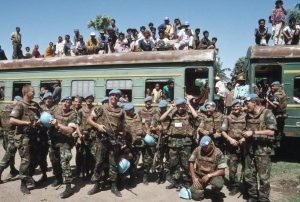Cambodian Prime Minister Hun Sen’s recent state visit to Myanmar has triggered an avalanche of criticism from observers both in Myanmar and abroad. The move was widely interpreted as a major step towards legitimizing Myanmar’s military junta, formally called the State Administration Council (SAC), despite its failure to adhere to ASEAN’s Five-Point Consensus peace plan. Interestingly, 33 years ago, Hun Sen himself was welcomed by then Thai Prime Minister Chatichai Choonhavan in an effort to break the stalemate in the Cambodian conflict. Many parallels can be drawn between the two cases.
Back in the 1980s, Southeast Asia was confronted with a dangerous strategic environment. One of the key concerns was the clash over Cambodia’s legitimate representation – much like the current issue of Myanmar’s representation at the United Nations. The two key rivals involved were the Vietnamese and Soviet-backed People’s Republic of Kampuchea (PRK), the de facto government of Cambodia following Vietnam’s toppling of the murderous Khmer Rouge regime in 1979, and the ousted remnants of the Khmer Rouge, who now called themselves the Party of Democratic Kampuchea (PDK).
Notwithstanding its genocidal rule, the PDK was internationally favored by the United States, China, and ASEAN. The U.S. and China’s decision to join hands was facilitated by several factors, including the Sino-Soviet split, the Sino-Vietnam conflict, and U.S.-China rapprochement. ASEAN, meanwhile, was concerned about Communist expansion and Vietnam’s regional dominance. Unlike its muted reactions to France’s 1978 intervention in Africa or the 1979 Soviet invasion of Afghanistan, ASEAN launched a diplomatic offensive to form an “internationally accepted” exiled resistance coalition, consisting of the DK and two other non-communist factions, to occupy Cambodia’s U.N. seat. On the ground, Thailand played an important role in cooperating with China to provide sanctuary and weapons for Khmer Rouge fighters in a guerrilla war against the Vietnamese occupation forces and their Cambodian allies.
From the mid-1980s onward, a small group of Thai academics started urging the government to stop supporting the Khmer Rouge and find alternative routes to end the prolonged war and diplomatic deadlock. But this plea did not attract much attention. Things took a different turn when Chatichai Choonhavan became Thailand’s Prime Minister in 1988. The newly elected Prime Minister Chatichai – the first elected civilian leader since 1976 – made clear that he wanted to turn Indochina “from a battlefield into a marketplace” and proceeded to warm relations with the internationally shunned Vietnam and the PRK Cambodian government headed by Hun Sen. In a grand gesture of reconciliation, Hun Sen was invited to Bangkok for formal talks in January 1989.
In Chatichai’s mind, old ideological divisions could be bridged by an all-inclusive regional economic prosperity. Adding to Chatichai’s strategic calculation was the ambition to turn Thailand into a leading economic power, with the Thai Baht as a key currency, in Indochina. This vision was excitedly backed by the Thai press and business community.
However, the foreign policy U-turn was not so acceptable in the political realm. Both the U.S. and China raised objections against Chatichai’s peace initiatives while S. Rajaratnam, one of ASEAN’s founding fathers from Singapore, voiced concerns about ASEAN’s credibility. Domestically, the hardline foreign minister Siddhi Savetsila together with former foreign minister and co-founder of ASEAN Thanat Khoman were among many prominent Thai officials who opposed Chatichai’s pragmatic approach.
But, despite these protests, Chatichai’s peace efforts eventually paid off. Trade between Southeast Asian nations grew significantly as the Cold War ended and ideological battles faded away. Cambodian factions were brought to the negotiating table and a U.N.-facilitated election was subsequently held in 1993. Ultimately, as noted by the distinguished scholar Amitav Acharya, Chatichai deserves full credit for taking initiatives to break ASEAN out of a decade-long deadlock on the Cambodian problem.
Fast forward to the present, Hun Sen has been vocal about his intention to engage directly with Myanmar’s SAC and become the new “peacemaker.” Hun Sen, with his first-hand experience in protracted civil war and peace negotiations, is arguably in a better position than Chatichai was back then. Within Cambodia, Hun Sen’s pro-engagement stance has been well received. Internationally, ASEAN is now much bigger and its member states have diverging interests in Myanmar. Besides, the U.S. and China no longer share a common enemy and find themselves in a fierce battle for hegemonic influence. Thus, unlike Chatichai, who faced a unified resistance from ASEAN members and the U.S.-China pact, Hun Sen’s Myanmar approach has generated mixed reactions at the government level.
Cambodia’s initiative has faced disapproval from Indonesia, Malaysia, the Philippines, and Singapore. However, it has been supported by Laos and Vietnam, and presumably Thailand – all of which do not want to pressure Myanmar. China, as Cambodia’s “ironclad friend,” has unsurprisingly vowed to “fully support” Cambodia in the peace process. Even Japan, a major U.S. treaty ally, has praised Hun Sen’s efforts. As an influential foreign investor in Myanmar, Japan prefers the use of dialogue and backdoor diplomacy over overt sanctions advocated by the U.S. and Europe.
It remains to be seen whether Hun Sen’s ice-breaking approach can convince Myanmar’s SAC to comply with, at the very least, the humanitarian goals of the Five-Point Consensus. Cambodia and the international community can only create a favorable environment for dialogue. How far the peace process can advance will depend entirely on Myanmar’s SAC, opposition factions, and the people of Myanmar.

































